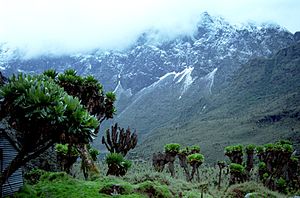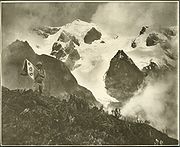
Rwenzori Mountains
Did you know...
This Schools selection was originally chosen by SOS Children for schools in the developing world without internet access. It is available as a intranet download. A good way to help other children is by sponsoring a child
The Rwenzori Mountains, previously called the Ruwenzori Range (the spelling having been changed in about 1980 to conform more closely with the local name) is a mountain range of central Africa, often referred to as Mt. Rwenzori, located on the border between Uganda and the DRC, with heights of up to 5,109 m (16,761 ft) at 0°23′09″N 29°52′18″E Coordinates: 0°23′09″N 29°52′18″E. The highest Rwenzoris are permanently snow-capped, and they, along with Mount Kilimanjaro and Mount Kenya are the only such in Africa.
Geologic history
The mountains formed about three million years ago in the late Pliocene as a result of an uplifted block of crystalline rocks such as: gneiss, amphibolite granite and quartzite, "pushed up by tremendous forces originating deep within the earth’s crust". This uplift divided the paleolake Obweruka and created two of the present-day African Great Lakes: Albert and Edward and George on the flanks of the Albertine (western) Rift of the East African Rift, the African part of the Great Rift Valley.
The range is about 120 km (75 mi) long and 65 km (40 mi) wide. It consists of six massifs separated by deep gorges: Mount Stanley (5,109m), Mount Speke (4,890m), Mount Baker (4,843m), Mount Emin (4,798m), Mount Gessi (4,715m) and Mount Luigi di Savoia (4,627m). Mount Stanley is the largest and has several subsidiary summits, with Margherita Peak being the highest point. The rock is metamorphic, and the mountains are believed to have been tilted and squeezed upwards by plate movement. They are in an extremely humid area, and frequently enveloped in clouds.
Human history
The Rwenzori range is the home of the Konjo and Amba peoples. In the early 1900s, these two tribes were added to the Toro Kingdom by the colonial powers. The Konjo and Amba agitated for separation from Toro beginning in the 1950s, a movement that became an armed secessionist movement, known as Rwenzururu, by the mid-1960s. The insurgency ended through a negotiated settlement in 1982, though the Rwenzururu Kingdom was acknowledged by the government in 2008.
The first modern European sighting of the Rwenzori was by the expedition of Henry Morton Stanley in 1889 (the aforementioned clouds are considered to explain why two decades of previous explorers had not seen them). On June 7, the expedition's second-in-command and its military commander, William Grant Stairs, climbed to 10,677 feet, the first known non-African ever to climb in the range. The first ascent to the summit was made by the Duke of the Abruzzi in 1906.
Flora and fauna
The Rwenzori are known for their vegetation, ranging from tropical rainforest through alpine meadows to snow; and for their animal population, including forest elephants, several primate species and many endemic birds. The range supports its own species and varieties of Giant groundsel and Giant lobelia and even has a six metre high heather covered in moss that lives on one of its peaks. Most of the range is now a World Heritage Site and is covered jointly by The Rwenzori Mountains National Park in Uganda and the Parc National des Virunga in Congo.
- Vegetation zones
- There are 5 different Vegetation Zones found in the Rwenzori Mountains. These are grassland (1000–2000m), montane forest (2000–3000m), bamboo/mimulopsis zone (2500–3500m), Heather/Rapanea zone (3000–4000m) and the afro-alpine moorland zone (4000–4500m). At higher altitudes some plants reach an unusually large size, such as lobelia and groundsels. The vegetation in the Rwenzori Mountains is unique to equatorial alpine Africa.
| Meters Order |
1500 | 2000 | 2500 | 3000 | 3200 | 3400 | 3600 | 3800 | 4000 | 4200 | 4400 | 4600 | 4800 | 5000 | 5100 |
|---|---|---|---|---|---|---|---|---|---|---|---|---|---|---|---|
| Lamiales | Mimulopsis elliotii Mimulopsis arborescens |
||||||||||||||
| Rosales | Prunus africana | Hagenia abyssinica | |||||||||||||
| Alchemilla subnivalis Alchemilla stuhlmanii Alchemilla triphylla Alchemilla johnstonii |
|||||||||||||||
| Alchemilla argyrophylla | |||||||||||||||
| Fabales | Albizia gummifera | ||||||||||||||
| Cornales | Alangium chinense | ||||||||||||||
| Malpighiales | Casearia battiscombei Croton macrostachyus Neoboutonia macrocalyx Symphonia globulifera |
Hypericum sp |
|||||||||||||
| Hypericum revolutum Hypericum bequaertii |
|||||||||||||||
| Asparagales | Scadoxus cyrtanthiflorus | ||||||||||||||
| Disa stairsii | |||||||||||||||
| Asterales | Dendrosenecio erici-rosenii | ||||||||||||||
| Dendrosenecio adnivalis Helichrysum sp. Lobelia bequaertii Lobelia wollastonii |
Helichchrysum guilelmii | ||||||||||||||
| Helichchrysum stuhlmanii | |||||||||||||||
| Senecio transmarinus Senecio mattirolii |
|||||||||||||||
| Apiales | Peucedanum kerstenii | ||||||||||||||
| Myrtales | Syzygium guineense | ||||||||||||||
| Sapindales | Allophylus abyssinicus | ||||||||||||||
| Gentianales | Tabernaemontana sp. | Galium ruwenzoriense | |||||||||||||
| Ericales | Pouteria adolfi-friedericii | Erica arborea Erica trimera |
|||||||||||||
| Erica silvatica Erica johnstonii |
|||||||||||||||
| Brassicales | Subularia monticola | ||||||||||||||
| Primulales | Rapanea rhododendroides | ||||||||||||||
| Ranunculales | Ranunculus oreophytus Arabis alpina |
||||||||||||||
| Santalales | Strombosia scheffleri | ||||||||||||||
| Poales | Yushania alpina | Carex runssoroensis Festuca abyssinica |
|||||||||||||
| Poa ruwenzoriensis | |||||||||||||||
| Lecanorales | Usnea | ||||||||||||||
| Order Meters |
1500 | 2000 | 2500 | 3000 | 3200 | 3400 | 3600 | 3800 | 4000 | 4200 | 4400 | 4600 | 4800 | 5000 | 5100 |
Sources:
Glacial recession in Rwenzori
A subject of concern in recent years has been the impact of climate change on Rwenzori's glaciers. In 1906 the Rwenzori had 43 named glaciers distributed over 6 mountains with a total area of 7.5 km²., about half the total glacier area in Africa. By 2005, less than half of these survive, on only 3 mountains, with an area of about 1.5 km². Recent scientific studies such as those by Dr Richard Taylor of University College London have attributed this to global climate change, and investigated its impact on the mountain's vegetation and biodiversity. In general, though, glacier growth and recedence are not necessarily tied to trends in temperatures as much as trends in precipitation.






